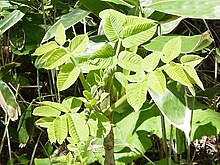Toxicodendron vernicifluum
| Toxicodendron vernicifluum | |
|---|---|

| |
| Scientific classification | |
| Kingdom: | Plantae |
| Clade: | Tracheophytes |
| Clade: | Angiosperms |
| Clade: | Eudicots |
| Clade: | Rosids |
| Order: | Sapindales |
| Family: | Anacardiaceae |
| Genus: | Toxicodendron |
| Species: | T. vernicifluum
|
| Binomial name | |
| Toxicodendron vernicifluum (Stokes) F. A. Barkley
| |



Toxicodendron vernicifluum (formerly Rhus verniciflua[1]), also known by the common name Chinese lacquer tree,[1][2][3] is an Asian tree species of genus Toxicodendron native to China and the Indian subcontinent, and cultivated in regions of China, Japan and Korea.[4] Other common names include Japanese lacquer tree,[5] Japanese sumac,[4] and varnish tree.[5] The trees are cultivated and tapped for their toxic sap, which is used as a highly durable lacquer to make Chinese, Japanese, and Korean lacquerware.
The trees grow up to 20 metres tall with large leaves, each containing from 7 to 19 leaflets (most often 11–13). The sap contains the allergenic compound urushiol, which gets its name from this species' Japanese name urushi (urushi (漆)); "urushi" is also used in English as a collective term for all kinds of Asian lacquerware made from the sap of this and related Asian tree species, as opposed to European "lacquer" or Japanning made from other materials. Urushiol is also the oil found in poison ivy and poison oak that causes a rash.
Uses
Lacquer
Products coated with
The leaves, seeds, and the
Buddhist monks who practiced the art of Sokushinbutsu would use the tree's sap in their ceremony.[citation needed]
Wax
The fruits of T. vernicifluum can also be processed to produce a waxy substance known as Japan wax used for numerous purposes including varnishing furniture and producing candles.[8][9] The fruits of the trees are harvested, dried, steamed, and pressed to extract the wax, which hardens when cooled.[10]
See also
References
- ^ a b "PLANTS Profile for Toxicodendron vernicifluum (Chinese lacquer)". Natural Resources Conservation Service. United States Department of Agriculture. Retrieved 8 August 2011.
- S2CID 22810554. Archived from the originalon 24 January 2021. Retrieved 10 December 2019.
- ISBN 978-0-521-41421-0.
- ^ a b "Toxicodendron vernicifluum". Germplasm Resources Information Network. Agricultural Research Service, United States Department of Agriculture. Retrieved 10 December 2013.
- ^ a b "Common Names for Chinese Lacquer (Toxicodendron vernicifluum)". Encyclopedia of Life. Retrieved 10 December 2013.
- ^ Fountain Pens made with Urushi lacquer Archived 16 March 2015 at the Wayback Machine
- PMID 18670102.
- ^ "国家标准计划 - 全国标准信息公共服务平台". std.samr.gov.cn. Retrieved 22 October 2019.
- ^ "惡魔植物---野生漆樹,一碰就會過敏水腫" (in Chinese (Taiwan)). Retrieved 22 October 2019.
- ^ 長崎新聞 (28 October 2018). "伝統産業 木蝋 こだわりの製法貫く | 長崎新聞". 長崎新聞 (in Japanese). Retrieved 22 October 2019.
Further reading
- Duke, James A.; Ayensu, Edward S. Medicinal Plants of China. Algonac, Mich.: Reference Publications, Inc. 1985. ISBN 0-917256-20-4.
- Matsuda, Gonroku (2019). The Book of Urushi. Japan Publishing Industry Foundation for Culture. ISBN 9784866580609.
- Kim, Ki Hyun; Moon, Eunjung; Choi, Sang Un; Pang, Changhyun; Kim, Sun Yeou; Lee, Kang Ro (13 March 2015). "Identification of cytotoxic and anti-inflammatory constituents from the bark of Toxicodendron vernicifluum (Stokes) F.A. Barkley". Journal of Ethnopharmacology. 162: 231–237. PMID 25582488.
- Stutler, Russ. "A Little more information on Urushi" Archived 22 October 2006 at the Wayback Machine. December 2002.
- Suganuma, Michiko. "Japanese lacquer".
